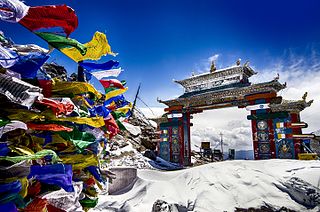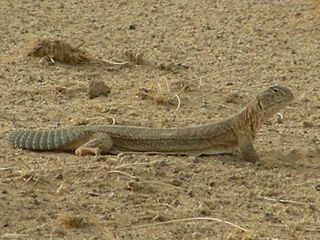
Nagaland is a landlocked state in the north-eastern region of India. It is bordered by the Indian states of Arunachal Pradesh to the north, Assam to the west, Manipur to the south, and the Naga Self-Administered Zone of the Sagaing Region of Myanmar (Burma) to the east. Its capital city is Kohima and its largest city is the twin Chümoukedima–Dimapur. The state has an area of 16,579 square kilometres (6,401 sq mi) with a population of 1,980,602 as per the 2011 Census of India, making it one of the smallest states of India.

Northeast India, officially known as the North Eastern Region (NER), is the easternmost region of India representing both a geographic and political administrative division of the country. It comprises eight states—Arunachal Pradesh, Assam, Manipur, Meghalaya, Mizoram, Nagaland and Tripura, and the "brother" state of Sikkim.

The gayal, also known as the Drung ox or mithun, is a large domestic cattle distributed in Northeast India, Bangladesh, Myanmar and in Yunnan, China.

The Insurgency in Northeast India involves multiple separatist militant groups operating in some of India's northeastern states, which are connected to the rest of India by the Siliguri Corridor, a strip of land as narrow as 14.29 miles (23.00 km) wide.

Nagas are various ethnic groups native to northeastern India and northwestern Myanmar. The groups have similar cultures and traditions, and form the majority of population in the Indian state of Nagaland and Naga Self-Administered Zone of Myanmar (Burma); with significant populations in Manipur, Arunachal Pradesh and Assam in India; Sagaing Region and Kachin State in Myanmar.

Entomophagy in humans or human entomophagy describes the consumption of insects (entomophagy) by humans in a cultural and biological context. The scientific term used in anthropology, cultural studies, biology and medicine is anthropo-entomophagy. Anthropo-entomophagy does not include the eating of arthropods other than insects such as arachnids and myriapods, which is defined as arachnophagy.
The Aos are a major Naga ethnic group native to Mokokchung District of Nagaland in Northeast India. Their main territory is from Tsüla (Dikhu) Valley in the east to Tsürang (Disai) Valley in the west in Mokokchung District.

Mongsen Ao is a member of the Ao languages, a branch of the Sino-Tibetan languages, predominantly spoken in central Mokokchung district of Nagaland, northeast India. Its speakers see the language as one of two varieties of a greater "Ao language," along with the prestige variety Chungli Ao.

Saara hardwickii, commonly known as Hardwicke's spiny-tailed lizard or the Indian spiny-tailed lizard is a species of lizard in the family Agamidae. The species is found in patches across the Thar desert, Kutch, and surrounding arid zones in India and Pakistan. It is mainly herbivorous and lives in numbers in some areas. Since it is found in loose clusters it often attracts predators such as raptors. It is also hunted by local peoples in the belief that the fat extracted from it is an aphrodisiac.
The Chakhesangs are a major Naga ethnic group inhabiting the Northeast Indian state of Nagaland. Chakhesangs were previously known as the former Eastern Angami, now recognized as a separate ethnic group. The Chakhesangs are divided into two groups known as Chokri and Kuzhami. The name "Chakhesang" was created as an acronym from the names of three ethnic groups: the Chakrü (Chokri), Khezha (Kuzhami) and Southern Sangtam.
Naga shawls are traditional shawls with a distinctive pattern made by various Naga ethnic groups from Nagaland and its neighbouring areas in Northeast India. The Naga shawl or Chakhesang Shawls is registered under the Geographical indications (GI) of Nagaland by Government of India.

Temsüla Ao was an Indian poet, fiction writer, and ethnographer. She was a professor of English at North Eastern Hill University (NEHU) from where she retired in 2010. She served as the director of the North East Zone Cultural Centre between 1992 and 1997 on deputation from NEHU. She was awarded the Padma Shri award for her contribution to literature and education. Her book Laburnum For My Head received the Sahitya Akademi Award for English writing in the short story category. Her works have been translated into Assamese, Bengali, French, German, Hindi, and Kannada.
The Khiamniungans are a Naga ethnic group, with approximately 35% of the population inhabiting in Noklak District in the Northeast Indian state of Nagaland and the rest in the Naga Self-Administered Zone and Hkamti District of Myanmar. They were also called Kalyo-Kengnyu during the British Raj.
The Changs are a Naga ethnic group inhabiting the Northeast Indian state of Nagaland. They were also known as Mazung in British India. Other Naga ethnic groups know the Changs by different names including Changhai (Khiamniungan), Changru (Yimkhiung), Duenching, Machungrr (Ao), Mochumi (Sümi) and Mojung (Konyak).
The Phoms are a Naga ethnic group native to the Northeast Indian state of Nagaland. Their traditional territory lies between the territories of Konyak in the north-east, the Ao in the west and the Chang in the south. Phoms celebrate several festivals in a year of which Monyiü is the greatest. It is celebrated from April 1 to 6 every year. Other traditional festivals include Moha, Bongvüm and Paangmo. They primarily inhabit the Longleng District.

Apo, apong, or poka is an alcohol drink commonly found among the tribes in the Northeast India states of Arunachal Pradesh and Assam. It is prepared by fermentation of rice. It is known by various names across different tribes in Arunachal Pradesh and Assam.
Mayangnokcha Ao (1901–1988) was an Indian educationist and writer from Nagaland and the founder, vice president of the Naga National Council.
A Tsüngkotepsü is a warrior shawl created by the Ao Nagas of Nagaland. Traditionally, the Tsüngkotepsü could only be worn by warriors who had successfully taken the heads of enemy warriors, In modern times, the right to wear the Tsüngkotepsü is associated with performing a mithun sacrifice, a demonstration of wealth and are a distinctive symbol of the Ao Nagas.

Entomophagy is the practice of eating insects. An alternative term is insectivory. Terms for organisms that practice entomophagy are entomophage and insectivore.











